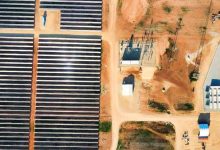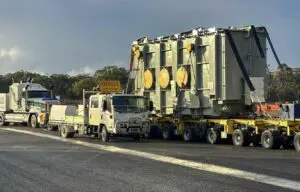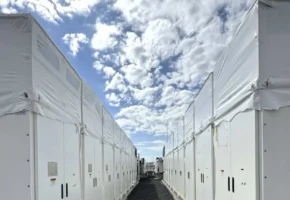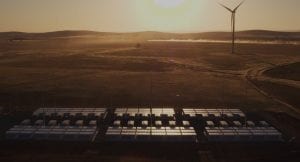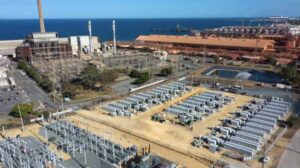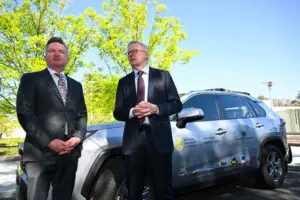One day, some time soon, you would expect Australia prime minister Scott Morrison to come out and say something really positive about battery storage, if only to demonstrate that his understanding of energy technology has entered the same century as his tenure in Kirribilli House.
Morrison’s grip on energy, climate science, and the role that electricity grids can and should play in emission reductions is tenuous at best, given that he has brandished a lump of coal in parliament (“don’t be afraid”), argued for a transition to gas (“you’re either for or against us”), and rubbished the Tesla big battery at Hornsdale as being about as useful as the Big Banana, a tourism gimmick in Coffs Harbour.
But just about everyone else in Australia – beyond the PM’s office and the government-owned Snowy Hydro – is taking battery storage very seriously, and that includes nearly all the state and territory governments, the Australian Energy Market Operator, the network companies, key institutions like ARENA and the CEFC, wind and solar developers, energy retailers, homeowners and businesses, and of course the battery storage providers themselves.
On Thursday, the biggest big battery in Australia, the largest in the southern hemisphere was unveiled by the Victoria government, Tesla and developer Neoen. The Victorian Big Battery will lift the capacity of the main link between Victoria and NSW and contract most of its capacity to AEMO’s grid protection scheme, using its rapid and flexible response.
At 300MW and 450MWh, the Victorian Big Battery will be more than double the size of the recently expanded Tesla big battery at Hornsdale, also owned and operated by Neoen, and it will be one of the biggest in the world. But more importantly, it is just the latest of more than a dozen big battery projects to be formally announced in the last few months, with many more in the pipeline.

Let’s look at what has been announced in recent times.
This week the Northern Territory Labor government opened the formal tender process for its 35MW Darwin big battery (with about half an hour storage) that will displace significant amounts of gas generation and allow for more rooftop and utility scale solar.
The South Australia government this week signed a 10 year electricity supply deal with Zen Energy that will see the 100MW and 100MWh Playford big battery built near Port Augusta , along with the 280MW Cultana solar farm at Whyalla.
Last week, Transgrid announced it would build a 50MW and 75MWh big battery at Wallgrove in western Sydney, which will provide synthetic inertia and other important grid services, and will be operated by Infigen Energy and which will also serve to “firm” up that company’s wind portfolio.
Last month, the Western Australia government announced a 100MW and 200MWh big battery to be built near Kwinana, again helping displace gas generation and reducing the wear and tear on ageing fossil fuel generators as they cope with the increasing amounts of rooftop solar and large scale wind and solar.
The NSW government in August announced it would support the construction of four new big batteries, including a 30MW battery at the Sapphire renewable energy hub, a 50MW battery at the proposed New England solar farm, a 12MW battery thought to be slated for Goldwind’s Gullen Range wind and solar hub, and 6MW of distributed batteries aggregated into a virtual power plant.
Another two big batteries may also be supported by the NSW government, depending on the outcome of feasibility studies.
The ACT government in September announced two new big batteries will be built as a result of its latest tender to push it beyond 100 per cent renewables as it seeks to electricity transport and buildings and further reduce emissions. They are a 50MW battery with two hours storage from Neoen and a 10MW/20MWh battery from Global Power Generation.
The re-elected ACT Labor government has also committed to building a 250MW big battery in Canberra to boost its own local network, and increase the amount of wind and solar power produced under contract that is matched with its usage.
And then there are the big utilities. Big batteries are being considered by network owners to offset the cost of grid upgrades, and the commissioning of the Victoria big battery will likely accelerate that process. Many are already pushing into community scale batteries to remove the need for network upgrades and to help integrate more rooftop solar.
The big “gentailers” are also moving into battery storage, to help replace the ageing coal generators that are about to leave the grid, and as an alternative to peaking gas generators.
AGL has contracted Maoneng to build 200MW and 400MWh of big batteries in NSW, including one at the Sunraysia solar farm, and is already building a 100MW and 150MWh big battery to be positioned next to the proposed Wandoan solar farm in Queensland, and has flagged a big battery of up to 500MW at the site of the soon to be closed Liddell coal generator.
In all, AGL plans up to 1,200MW of battery storage by 2024, and heralded the “dawn” of the battery age, which it describes as a “game changer” for the grid.
Origin Energy is also looking at five different battery storage possibilities, including at up to four of its existing fossil fuel generators, and a separate 300MW project at Morgans in South Australia, but says the plans are hostage to federal government market intervention, and particularly its controversial, and secretive, Underwriting New Generation Investment scheme. Infigen has echoed those complaints.
Alinta and Fortescue are looking at more big batteries in the expanded Pilbara grid that will supply most of the big iron ore mining operations in the region and enough solar capacity to power the operations during daytime hours. Alinta already operates the highly successful 30MW/12MWh Newman battery, which is delivering a payback of less than five years, and making the local grid more reliable.
And, of course, there is the biggest proposal of them all – the massive 20GWh (gigawatt hour) battery to go with the proposed Sun Cable solar farm in the Northern Territory that could deliver power to Singapore via an undersea cable more than 3,700km long.
Just about wind and solar project proposed for the grid now arrives as “battery ready”, preparing for the market signals and rule changes that will make the addition of storage a lot easier than it is now.
And let’s not forget the tens of thousands of small batteries being installed at an increasingly rapid rate by households and businesses to store rooftop solar and deliver increased resilience and standalone power, and which are also being aggregated in an increasing number of ever larger virtual power plants which will play an important role in the grid.
Why the surging interest in battery storage? As Sophie Vorrath wrote last week, noting the performance of a Tesla battery array at the University of Queensland, they are faster, cheaper and smarter than other options, and particularly gas-fired peaking plants – the thrust of the federal government’s energy policy and technology roadmap.
Hornsdale has proven to be essential to AEMO’s list of tools to keep the lights on, and has sheltered the South Australian grid from the storms that have torn down the interconnectors on occasions, and has also delivered handsome returns to both its owners Neoen, and to consumers through its interventions.
The other big batteries already operating, from the Newman battery in the Pilbara, through to Lake Bonney and Dalrymple North batteries in South Australia, and the Gannawarra and Ballarat batteries in Victoria, have also proved highly successful.
Costs of battery storage are coming down. Neoen’s Australian boss Louis de Sambucy said this week that the Victorian big battery will be 15 per cent lower per megawatt hour than just two years ago, and the costs are still falling.
And they are versatile, with one big battery able to perform multiple different functions, including increasing capacity on transmission links, providing emergency security response, frequency control, synthetic inertia, and also simply as a storage device, charging at times of low prices and discharging at times of peak demand, when prices usually rise.
In all, there are about 20 different services in the battery storage “value pack”. But as Neoen’s de Sambucy notes: “They can do a lot of things that are not fully recognised by the market because the marketplace was designed in a certain way.
“But we are optimistic that the changes that are happening and that the batteries will be able to provide more and more services that are needed in the network.”
And while the batteries are getting bigger in terms of capacity in MW terms, the storage is also getting longer (MWh), reflecting the falling costs that make it economic to store for multiple hours. Tesla’s Robyn Denholm says “humungous” batteries will become a mainstream feature of the renewables grid.
In the case of the Victorian big battery, the bulk of the capacity (250MW) but just over one quarter of the storage (125MWh) will be reserved for the market operator’s grid security program, where the length of storage is not important. The rest, 50MW and 325MWh (or more than six hours of storage), will play in the other markets.
And as Tesla chair Robyn Denholm noted yesterday, they will get bigger and bigger, matching the potential of giga-watt scale gas generators, delivering cheaper, cleaner and smarter technology that can be built in a fraction of the time.
Still, like the PM, some don’t get it. Victoria Liberal leader Michael O’Brien completely misunderstood the purpose of the battery and echoed the “Kardashian” put down of battery storage from former resources minister Matt Canavan, by saying that the battery would only last 1.5 hours, or three episodes of Keeping Up with the Kardashians.
To which the Climate and Energy College’s Dylan McConnell replied: “From now on, I will be exclusively referring to 30-minute trading intervals as ‘Kardashian Intervals’.”
He has a point, like the Kardashian’s, 30-minute intervals will soon be redundant, replaced by 5-minute trading that will favour the quicker batteries. And O’Brien does need to keep up: Apparently the Kardashian programs last much longer than half an hour.

